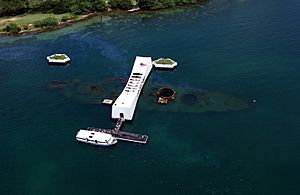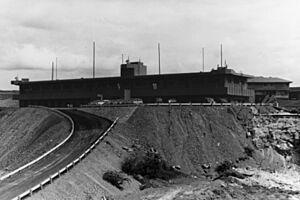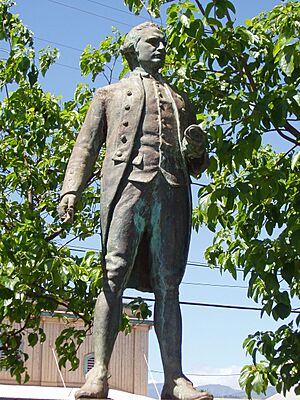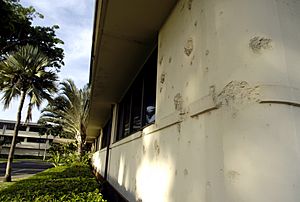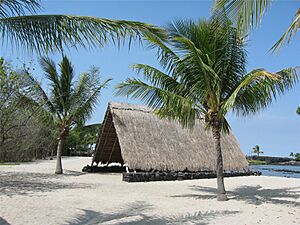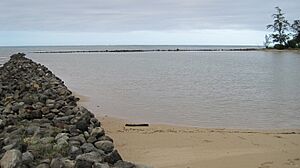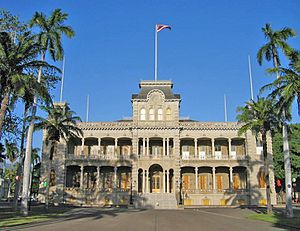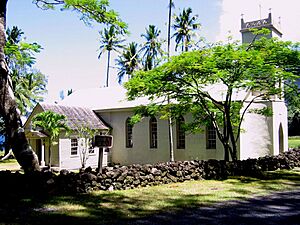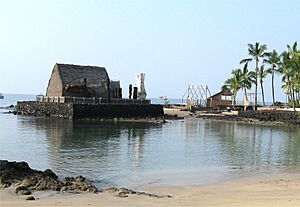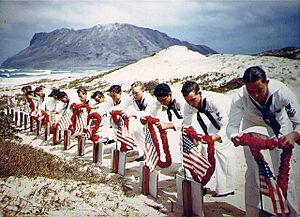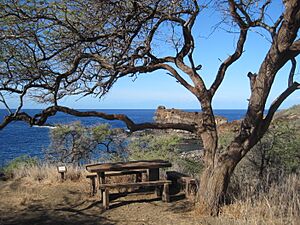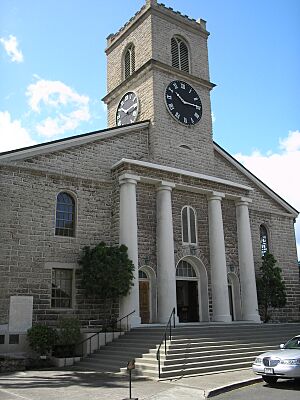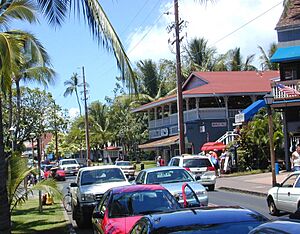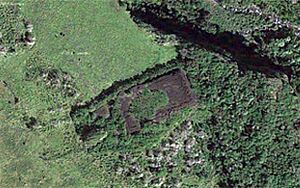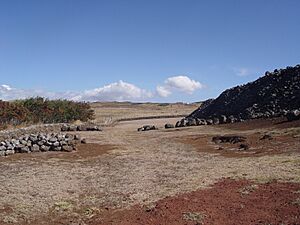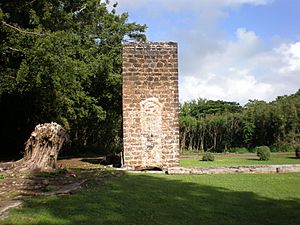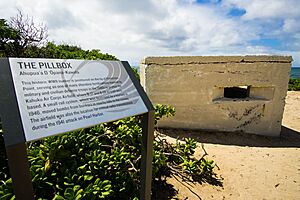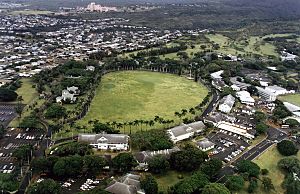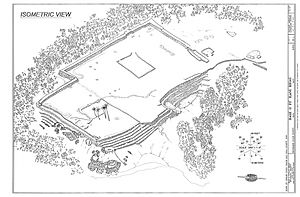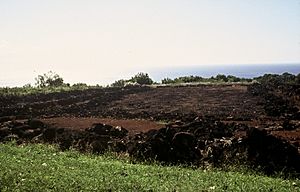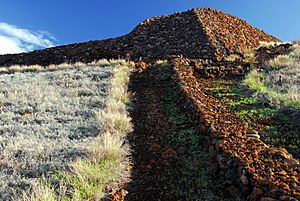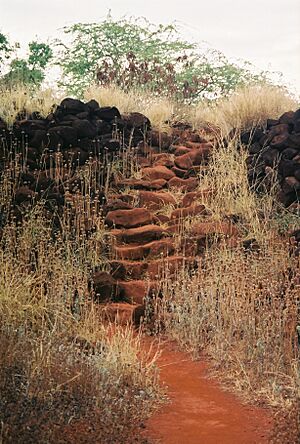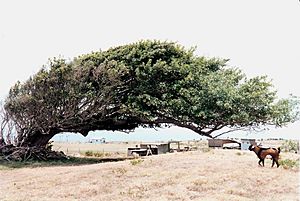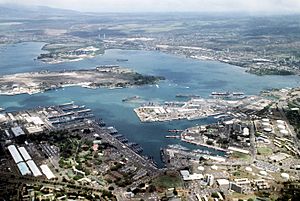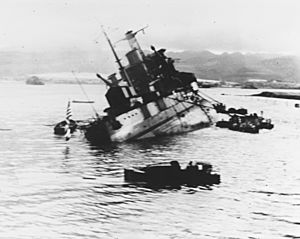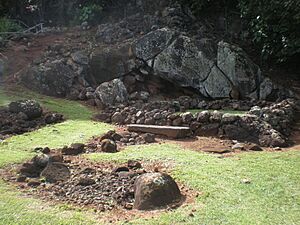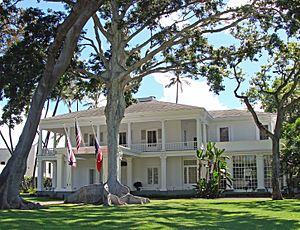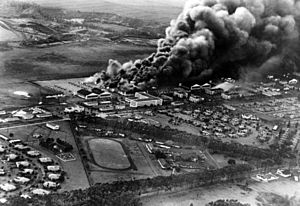List of National Historic Landmarks in Hawaii facts for kids
The United States National Historic Landmark program helps protect amazing places across the country. These special places can be buildings, areas, or even objects that are super important to American history. Hawaiʻi has 33 of these landmarks! Many of them tell stories about World War II and the incredible ancient Hawaiians.
These landmarks are spread across six of Hawaiʻi's islands. Most of them (16) are on Oʻahu. Let's explore some of these cool spots!
Contents
- Historic Places in Hawaiʻi
- USS Arizona Shipwreck
- USS Bowfin Submarine
- CINCPAC Headquarters
- Cook Landing Site
- Hickam Field
- Honokohau Settlement
- Huilua Fishpond
- 'Iolani Palace
- Kalaupapa Leprosy Settlement
- Kamakahonu
- Kaneohe Naval Air Station
- Kaunolu Village Site
- Kawaiahaʻo Church
- Keauhou Holua Slide
- Lahaina Historic District
- Loaloa Heiau
- Mauna Kea Adz Quarry
- Mookini Heiau
- Old Sugar Mill of Koloa
- Opana Radar Site
- Palm Circle
- Piilanihale Heiau
- Pu'u O Mahuka Heiau
- Puukohola Heiau
- Russian Fort Elizabeth
- South Point Complex
- United States Naval Base, Pearl Harbor
- USS Utah Shipwreck
- Wailua Complex of Heiaus
- Washington Place
- Wheeler Field
- National Park Service Areas in Hawaii
- See also
Historic Places in Hawaiʻi
USS Arizona Shipwreck
The USS Arizona was a huge battleship. It was sunk during the Japanese attack on Pearl Harbor on December 7, 1941. Today, its remains are still in Pearl Harbor, and a special memorial stands over it. It reminds us of the brave people who lost their lives that day.
USS Bowfin Submarine
The USS Bowfin was a US Navy submarine. It was very important during World War II, sinking 16 Japanese ships! After the war, it became a museum ship. You can visit it in Pearl Harbor and learn what life was like inside a submarine.
CINCPAC Headquarters
This building was the main office for Admiral Chester W. Nimitz from 1942 to 1945. He was a very important leader during World War II in the Pacific. This headquarters helped plan many big operations.
Cook Landing Site
This spot in Waimea is where Captain James Cook landed on January 20, 1778. He was the first European to see the Hawaiian Islands. His arrival changed Hawaiʻi forever.
Hickam Field
Hickam Field was a major target during the attack on Pearl Harbor. This Air Force Base played a super important role throughout the entire World War II Pacific campaign. It's a reminder of the start of the war for the U.S.
Honokohau Settlement
This is an ancient Hawaiian village site. You can find old fishponds, house platforms, kiʻi pōhaku (rock carvings or petroglyphs), and heiau (religious sites) here. It shows us how ancient Hawaiians lived.
Huilua Fishpond
The Huilua Fishpond is the last working ancient Hawaiian fishpond on Oʻahu. Long ago, there were about 97 of these amazing structures! Hawaiians built them to raise fish, showing their clever farming skills.
'Iolani Palace
ʻIolani Palace is super special because it's the only royal palace in the United States that was actually used by a reigning monarch. It was the official home of Hawaiʻi's kings and queens.
Kalaupapa Leprosy Settlement
Founded in 1866, Kalaupapa was a place for Hawaiians with leprosy to live. It's now part of the Kalaupapa National Historical Park. It tells a powerful story of isolation, care, and the people who lived there.
Kamakahonu
This site was the final home of King Kamehameha I, the great king who united the Hawaiian Islands. It's a very important place in Hawaiian history.
The Kaneohe Naval Air Station was attacked by the Japanese just minutes before the main attack on Pearl Harbor. This early attack was meant to stop American planes from flying.
Kaunolu Village Site
This old fishing village on Lānaʻi was abandoned in the 1880s. It's the largest and best-preserved example of a prehistoric Hawaiian village. It's like stepping back in time!
Kawaiahaʻo Church
Kawaiahao Church was once the national church of the Hawaiian Kingdom. It was also the special chapel for the royal family. It's a beautiful building with a lot of history.
Keauhou Holua Slide
This is the biggest and best-preserved hōlua course. A hōlua was a special stone slide used for a type of sledding, but only chiefs were allowed to do it! It was a very exciting and dangerous activity.
Lahaina Historic District
The Lahaina Historic District on Maui helps us imagine what a Hawaiian seaport was like in the mid-1800s. It's full of old buildings and stories from that time.
Loaloa Heiau
Loaloa Heiau is a large and well-preserved luakini heiau. These were special temples used by the state in ancient Hawaiʻi.
Mauna Kea Adz Quarry
This site on Mauna Kea Ice Age Reserve was used by prehistoric Hawaiians to get basalt rock. They used this rock to make stone tools. You can also find religious shrines, trails, rockshelters, and petroglyphs here.
Mookini Heiau
Mookini Heiau is a temple built way back in 480 A.D.! It was dedicated to Kū, the Hawaiʻian god of war. It's an amazing example of ancient Hawaiian architecture.
Old Sugar Mill of Koloa
The Old Sugar Mill of Koloa was the first successful sugarcane plantation in Hawaiʻi. It played a big part in the state's economic history.
Opana Radar Site
This site is important because it's where the United States first used radar in wartime. This happened during the attack on Pearl Harbor. It shows how new technology was used in the war.
Palm Circle
Palm Circle is part of Fort Shafter. During World War II, it was the main office for the U.S. Army forces in the Pacific. They planned how to supply and manage all the soldiers in the Central and South Pacific.
Piilanihale Heiau
Pi'ilanihale Heiau is an ancient temple in Polynesia. It was built from lava blocks in the 16th century. It's a huge and impressive structure.
Pu'u O Mahuka Heiau
Pu'u O Mahuka Heiau is another ancient temple. It might have been a place where sacrifices were made. It offers amazing views of the ocean.
Puukohola Heiau
The ruins of Puukohola Heiau are known as the "Temple on the Hill of the Whale." King Kamehameha I built this temple between 1790 and 1791.
Russian Fort Elizabeth
Russian Fort Elizabeth was built in 1816. It was a result of an alliance between High Chief Kaumualii and a Russian company. It's a unique piece of Hawaiian history.
South Point Complex
South Point Complex is the southernmost point in the United States! It's also one of the earliest places where Hawaiians settled. It's a windy but beautiful spot.
Pearl Harbor is famous as the site of the attack on Pearl Harbor by Japan on December 7, 1941. It's a very important place in American history.
USS Utah Shipwreck
The USS Utah was another ship sunk by the Japanese during the attack on Pearl Harbor. Its remains are still in Pearl Harbor, serving as a memorial.
Wailua Complex of Heiaus
The Wailua Complex of Heiaus is an archaeological site on Kauaʻi with four heiaus. It's a great place to learn about ancient Hawaiian religious practices.
Washington Place
Washington Place was built in 1844–1847. It was the home of Queen Liliʻuokalani, the last queen of the Hawaiian kingdom. She lived here from 1862 until she passed away in 1917. She saw the monarchy overthrown and Hawaiʻi become part of the United States. Later, it was used as the home for Hawaiʻi's governors.
Wheeler Field
Wheeler Field was another main target during the attack on Pearl Harbor. The damage here allowed the Japanese to control the skies during the attack.
National Park Service Areas in Hawaii
Besides the landmarks listed above, Hawaiʻi also has five special areas managed by the U.S. National Park Service that are important for history.
Some of these, like the USS Arizona Memorial, Kaloko-Honokohau National Historical Park, Kalaupapa National Historical Park, and Puukohola Heiau National Historic Site, are also National Historic Landmarks and are mentioned above.
Another important historical park is Pu'uhonua o Honaunau National Historical Park. This park was created in 1955, even before the National Historic Landmarks program started. It's a place of refuge where ancient Hawaiians could find safety.
See also


